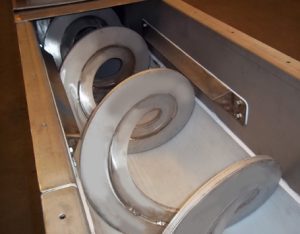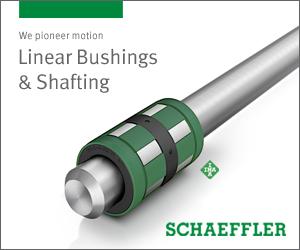The screw conveyor is a cost-effective, versatile, and rugged conveying solution ideal for hard-to-transport materials ranging from irregularly shaped dry solids such as scrap wood and metals to semi-liquid and sticky materials including pulp, compost, food processing refuse, hospital waste, and wastewater products.
The shaftless design can be used as either a screw conveyor or a screw feeder to transfer bulk materials horizontally, vertically, or even at varying degrees of incline.


But, what makes them different from their shafted counterpart?
Shaftless vs Shafted Screw Conveyor
The shaftless screw conveyor is fairly similar to the conventional shafted screw conveyor in design and construction—both consist of a spiral or screw, troughs, trough ends, bearings, inlets, discharges, covers, and a drive unit.
The unique difference, though, is in the spiral/screw.
A conventional shafted screw conveyor has a center pipe to support the screw flights, and the pipe is supported on each end by bearings. Typically, there is a half-inch gap between the outside diameter of the screw and the inside diameter of the trough. Therefore, the screw never touches the bottom of the trough.
A shaftless conveyor, on the other hand, is designed to be supported by a liner that conforms to the radius of the trough and distributes the weight throughout the length of the spiral. Additionally, the drive is connected to one end of the spiral by means of a flanged and bolted drive shaft and spiral endplate, while the tail end of the spiral is not connected and is allowed to rotate freely.
Selecting the Best Shaftless Screw Conveyor for your Application
When selecting the proper shaftless screw conveyor for your application, many factors must be considered: the spiral strength & hardness, torsional ratings, and the material of the trough liner.
The strength and hardness of the spiral are very important to the long-term success of the installation. For example, if you are conveying an abrasive bulk solid, you need a spiral that is extremely hard in order to reduce the amount of abrasion on the shaftless spiral.
Secondly, make sure the shaftless screw conveyor manufacturer can back up their design with calculations for the torsional rating of the spiral. Since there is no center pipe to transmit torque, the shaftless spiral must be designed to handle the full-torque load of the drive unit.
Lastly, the trough liner material can make or break the long-term success of your screw conveyor. Typical trough liner materials are ultra-high molecular weight polyethylene (UHMW) or xylethon. Both of these materials are tough and have a low coefficient of sliding friction. Since the spiral is bearing down on the line and rotating, it helps to have a tough, slick liner material. And, since the liner material is typically the wear item, it is easier and less expensive to replace than the shaftless spiral.
Martin Reduces Costs with Material Handling Solutions
When a meat processing plant was experiencing unexpected downtime in the conveyor lines, Martin discovered irregularly sized materials would get caught between the hanger frames and the conveyor trough, resulting in damage to both the hangers and hanger bearings.
Martin reviewed the Conveyor System and recommended a conveyor redesign to include close-coupled and clocked screws. The new design is free of Hangers and Hanger Bearings and includes T1 Trough Liners, Hold-Down Angles, and a larger Shaft.
Since installing the new conveyor in their facility, the plant has avoided 4 outages per year. The cost savings from the prevented outages are equal to $231,410.00 when the cost of new conveyors has been deducted.
Learn More from IBT’S Screw Conveying Systems Experts
Screw conveyors can be designed and manufactured using a variety of standard and nonstandard materials to fit any custom application. As specialists in the conveying systems field, the IBT Industrial Solutions team understands the importance of good systems application in achieving optimum efficiency.
With our years of experience in providing conveying systems and components, you can rely on IBT for the best solution to your problems. Contact Jim Boatright, the IBT Conveying Systems Business Group Director at (913) 261-2116 to learn more.





